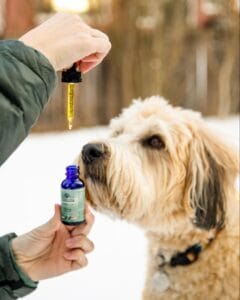Blog | CBD Oil Blog | Dogs
Joint Stiffness in Dogs: Common Signs & Management Tips
January 10, 2024
Written By: Earth Buddy Team

Joint stiffness in dogs is a condition that can profoundly affect their quality of life and overall well-being. This issue goes beyond just a reduction in physical activity; it also impacts their emotional state. Dogs who suffer from joint stiffness may experience discomfort during movement, which can significantly limit their ability to engage in activities they once enjoyed. If your dog is experiencing joint issues, searching for a way to promote mobility is important.
What Can Cause of Joint Stiffness in Dogs
The primary, actual root cause of joint issues in both humans and animals, including dogs, is often attributed to wear and tear over time. This wear and tear primarily affects the cartilage, the resilient and flexible tissue that cushions the joints. Cartilage plays a crucial role in helping maintain joint mobility by preventing bones from rubbing directly against each other.
As many dog breeds age, or as a result of repetitive movements and stress on the joints, this cartilage can gradually deteriorate. The process typically starts with the thinning of the cartilage, which reduces its effectiveness as a cushion. Over time, and especially without any intervention to slow the process, the cartilage may continue to wear down. Eventually, it can become so thin that it offers little to no cushioning effect.
In severe cases, the cartilage might wear away entirely, resulting in bone-on-bone contact within the joint. This can cause significant discomfort, as the natural shock-absorbing properties of the cartilage are lost. The lack of cushioning can lead to stiffness and reduced mobility significantly impacting the quality of life of the affected animal.
Your Dog’s Joint Aches and Aging
Older dogs are more susceptible to joint issues, which can gradually impact how they move around and lower their quality of life. Early detection of joint stiffness or other health problems can significantly improve the chances of successful management.
Regular veterinary check-ups become increasingly important for older dogs. Veterinarians can conduct physical examinations and possibly recommend imaging tests like X-rays to assess the condition of the joints. Although they may not be able to pinpoint an obvious cause, they can provide tailored advice and treatment plans based on the individual dog’s health status, look into potential underlying causes, and evaluate your dog’s specific needs.
Why is My Dog Suddenly so Stiff? Signs of Joint Stiffness in Dogs
Detecting joint problems or other health issues in dogs can be challenging for many pet parents, as dogs are naturally adept at concealing discomfort. This tendency to hide vulnerabilities stems from their instincts, where showing weakness could have been a disadvantage in their ancestral environment. Dogs often endure discomfort silently and may only show signs when the issue has become more severe. This could make it difficult to pinpoint the specific root cause, especially in older dogs.

This instinctual behavior to mask discomfort or aches make it crucial for pet owners to be vigilant and observant, particularly as their dogs age. To catch stiffness or for other conditions to be caught early, it’s important to pay close attention to subtle changes in your dog’s behavior and physical capabilities.
Signs that may indicate joint problems include a decrease in activity level, reluctance to jump or climb stairs, stiffness after resting, visible discomfort during movement, and changes in walking patterns.
You may also notice stiffness, irritability, frequent slipping, appetite depression, licking around the affected area, or a combination of all of these.
Losing Mobility and Independence
When their ability to engage in these activities is diminished, perhaps due to age-related issues like joint stiffness, it can significantly affect their mental and emotional well-being.
The loss of mobility and independence can also feel overwhelming to our dogs, as they become more dependent on their dog owners for assistance with daily activities.
Breeds Prone to Joint Issues
Many breeds, especially if they’re larger dogs, are prone to developing issues at some point in their lifetime. Large breed dogs grow more quickly than they’re sometimes ready to and they continue playing just the same as any other puppies would.
This results in larger dog breeds being more prone to developmental joint problems and more serious injuries when it comes to joint issues in many cases. The lack off well-developed muscles also poses a problem when it comes to joint support in fast growing pups.
Small dogs with long backs and short legs, like the Corgi or Dachshund, are also prone to joint complications.
The breeds most prone to developing joint problems include:
- Bernese Mountain Dogs (prone to ankle joint problems)
- German Shepherd
- Labrador Retriever
- Newfoundland
- Saint Bernard
- Great Dane
- Rottweiler
- Mastiffs
- Old English Sheep Dog
- Dachshund
- Bulldog
- Basset Hound
These dog breeds in particular should be monitored closer than most other dog breeds that are less likely to develop these types of problems.
Natural Ways to Help Your Dog’s Joints
There are medications available with your veterinarian that could be helpful, but there are also natural hip & joint supplements for dogs to help your pup at home. They don’t substitute medical advice, but a dog joint supplement may be used alongside it with your veterinarian’s approval and what they feel is appropriate treatment for your individual dog.
Maintain Healthy Weight to Promote Mobility
Maintaining a healthy weight can greatly impact your dog’s mobility, especially if they already have joint problems. Extra weight puts added pressure and strain on the joints and cartilage tissue. Check your dog’s current weight in comparison to their expected weight. You don’t want them to hold weight in places they shouldn’t.
Some dogs, like Labrador Retrievers, are more prone to obesity than others. To support proper weight management in dogs, especially those prone to weight gain, careful attention to their diet is essential. This includes:
- Appropriate portion sizes: Providing meals in the right portions is key to avoiding overfeeding. This may also help your dog lose weight if they are holding weight in the wrong places.
- Regular feeding schedule: Maintaining a consistent feeding schedule can help support a normal metabolic rate.
- Healthy treats: Be mindful of the quantity and quality of treats. Opt for healthy, low-calorie options and consider treats as part of the daily food intake.
Providing High Quality Diet for Your Pup’s Joints
Feeding a species-appropriate, high quality diet with variety goes along with maintaining a healthy weight. A high quality diet can help support joint health for dogs naturally. For example, fatty acids are vital to everyday health, strong muscles and healthy joints. Different types of meats, vegetables, and appropriate supplements can also provide a range of essential nutrients.
For dog joint health specifically, certain ingredients can be particularly beneficial. Omega-3 fatty acids, found in small, oily fishes, promote normal inflammatory pathways that can help alleviate joint stiffness.
Glucosamine, found in green-lipped mussels, may stimulate the production of proteoglycans which help maintain the health and resiliency of joints and connective tissue by helping maintain synovial fluid that lubricates joints.
Vets Explain Gentle Exercise for Joint Stiffness in Dogs
Gentle exercise plays a crucial role in managing and improving the mobility of dogs with physical limitations, like joint stiffness in dogs. While vigorous activity might be too strenuous for these dogs, moderate, low-impact exercise can help them maintain muscle strength, flexibility, and overall health without exacerbating their condition.
Providing your dog with short, gentle walks is an excellent way to keep your dog active and enjoying the benefits of exercise, while being mindful not to overburden their joints.
Short walks allow dogs with mobility issues to engage in physical activity that is within their comfort zone. These walks should be paced according to the dog’s ability, ensuring they do not experience discomfort.
It’s important to observe their reaction during and after the walk to gauge if the duration and intensity are suitable. If a dog shows signs of fatigue or discomfort, it may be necessary to shorten the walk or adjust the pace.
Adjusting Playtime According to Your Dog’s Joint Aches
Playtime can also be adjusted to suit a dog with mobility restrictions. Instead of vigorous games like fetch, consider more gentle activities that encourage movement without strain. For example, a simple game of hide and seek with treats can be both mentally stimulating and physically appropriate for a dog with joint issues.
Hydrotherapy for Dogs Experiencing Joint Stiffness
You may have heard doctors recommend hydrotherapy to people who are experiencing problems with their joints. The same goes for our dogs. Water buoyancy supports their weight, making it easier for them to move and providing a comfortable way to build muscle and maintain flexibility, in addition to reducing the strain on their joints. The warmth from the water also helps with occasional discomfort and helps promote normal circulation.
Generally, an underwater treadmill is used for dogs with mobility issues. The principle behind an underwater treadmill is a simple yet powerful exercise prescribed by many veterinarians. This reduction in weight bearing makes it easier for the dog to move on the treadmill, allowing for exercise with minimal discomfort.
Change Their Environment To Make Them Feel Like a Healthy Dog and Boost Their Confidence
Changes to your dog’s environment can help them with confidence and improve their mobility. Here are some tips:
- Non-slip flooring: Hardwood or tile floors can be slippery and challenging for dogs with mobility issues. Placing non-slip mats, rugs, or runners in areas where your dog frequently walks can provide them with better traction and reduce the risk of slipping and falling.
- Ramps and steps: For dogs who find it difficult to jump or climb, installing ramps or steps can help them access higher areas like beds, sofas, or cars more easily. These aids are especially useful for older dogs or those with limited mobility.
- Elevated food and water bowls: Raising the height of food and water bowls can reduce extra strain on your dog’s neck, back, and legs. This can be particularly helpful for dogs who have a hard time bending down to get a drink or a bite of food.
- Comfortable bedding: Orthopedic dog beds can provide extra support for aging joints and bones, helping to relieve occasional discomfort and promote relaxation. Ensure the bed is easily accessible and placed in a quiet, warm area.
- Clear pathways: Keep walkways clear of clutter to prevent your dog from having to navigate around obstacles. This is especially important for dogs with limited mobility or vision.
- Accessible rest areas: Ensure your dog has a stable and comfortable area where they can rest and observe their surroundings. Dogs often like to be where the family is, so having a designated spot in common areas can help them feel included without having to move around too much.
Full Spectrum CBDa for Dogs to Promote Healthy Joints

Joint supplements for dogs could be an option to help promote mental and physical well-being. One of the emerging dog joint supplements recommended by holistic practitioners tends to be full spectrum CBDa for Dogs (not for severe problems).
Full spectrum CBDa for dogs, or cannabidiolic acid, is increasingly being considered by holistic veterinarians and canine nutritionists for dogs experiencing joint issues. This natural remedy, derived from the hemp plant, contains a variety of compounds including cannabinoids, terpenes, and flavonoids, which work together to produce what is known as the “entourage effect”. This molecule has been shown to act on specific inflammatory response pathways associated with joint aches, making it one of the best hip & joint supplements for dogs.
These compounds may help support joint flexibility and mobility by:
- Stiffness: Easing joint stiffness due to normal daily exercise and activity
- Joint health: Enhancing bone and joint health
- Cartilage: Helping maintain normal healthy cartilage and joint function
- Tissue: Enhancing the functions of joint and connective tissue
- Bone and joint: Helping maintain healthy bone and joint function
Putting Everything Together
By implementing the strategies we discussed, you can help make your home a more supportive and comfortable environment for your dog, which can have a positive impact on their overall quality of life and mobility.
For further reading, we recommend:
- https://pubmed.ncbi.nlm.nih.gov/32345916/
- https://www.frontiersin.org/articles/10.3389/fvets.2023.1248417/full
- https://www.ncbi.nlm.nih.gov/pmc/articles/PMC9400326/
- https://www.nature.com/articles/s41419-020-02892-1
- https://www.sciencedirect.com/science/article/pii/S0363502322001332
- https://www.frontiersin.org/articles/10.3389/fvets.2023.1248417/full#:~:text=As%20a%20result%2C%20CBD%20could,every%2012%20h%20(18)
- https://www.annualreviews.org/doi/10.1146/annurev-animal-081122-070236
- https://www.ncbi.nlm.nih.gov/pmc/articles/PMC9856978/
You Might Also Enjoy
Your dog’s skin is their largest organ making dog skin care a crucial part of…
Like us, our dogs, and other mammalian species, cats have an endocannabinoid system. This system…
Learning how to calm a dog down is an essential skill to have in your…



